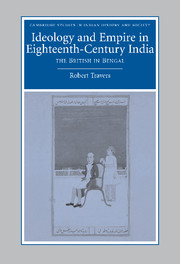Book contents
- Frontmatter
- Contents
- Preface and acknowledgements
- Abbreviations and note on currency
- Glossary of Indian terms
- Map of Bengal and Bihar in the Eighteenth-Century
- Introduction
- 1 Imperium in imperio: the East India Company, the British empire and the revolutions in Bengal, 1757–1772
- 2 Colonial encounters and the crisis in Bengal, 1765–1772
- 3 Warren Hastings and ‘the legal forms of Mogul government’, 1772–1774
- 4 Philip Francis and the ‘country government’
- 5 Sovereignty, custom and natural law: the Calcutta Supreme Court, 1774–1781
- 6 Reconstituting empire, c. 1780–1793
- 7 Epilogue
- Bibliography
- Index
- Cambridge Studies in Indian History and Society
2 - Colonial encounters and the crisis in Bengal, 1765–1772
Published online by Cambridge University Press: 18 July 2009
- Frontmatter
- Contents
- Preface and acknowledgements
- Abbreviations and note on currency
- Glossary of Indian terms
- Map of Bengal and Bihar in the Eighteenth-Century
- Introduction
- 1 Imperium in imperio: the East India Company, the British empire and the revolutions in Bengal, 1757–1772
- 2 Colonial encounters and the crisis in Bengal, 1765–1772
- 3 Warren Hastings and ‘the legal forms of Mogul government’, 1772–1774
- 4 Philip Francis and the ‘country government’
- 5 Sovereignty, custom and natural law: the Calcutta Supreme Court, 1774–1781
- 6 Reconstituting empire, c. 1780–1793
- 7 Epilogue
- Bibliography
- Index
- Cambridge Studies in Indian History and Society
Summary
Mir Qasim (1760–3) was the last nawab of Bengal to aspire to any real measure of independence from the Company's control. In 1763–4, the Company's army comprehensively defeated the combined forces of Mir Qasim, Shuja-ud-daula (nawab of the northern province of Awadh and vizier of the Mughal empire) and the impoverished Mughal emperor himself, Shah Alam II. From this point on, the Company was clearly the dominant military power in eastern India, even if Company officials still feared Maratha invasions from the west and the possibility of French attacks from the sea.
The nawab of Awadh was forced to pay a hefty tribute to the Company, and his military capacities were deliberately circumscribed. The captured emperor was settled under the protection of the Company's forces in Allahabad, and by a treaty of 1765 he appointed the Company as diwan of Bengal, an office described by Alexander Dow as the ‘receiver-general of the Imperial revenues in the province’. Mir Jafar, and after him his sons, held the office of nazim or imperial governor of Bengal, but they were in effect pensioners of the Company. Robert Clive, the governor of Bengal from 1765–7 who engineered the grant of the diwani, wrote to the directors that we must ‘become the Nabob ourselves in fact, if not in name’.
The years after the grant of the diwani were crucial in the political education of the East India Company service in Bengal.
- Type
- Chapter
- Information
- Ideology and Empire in Eighteenth-Century IndiaThe British in Bengal, pp. 67 - 99Publisher: Cambridge University PressPrint publication year: 2007



